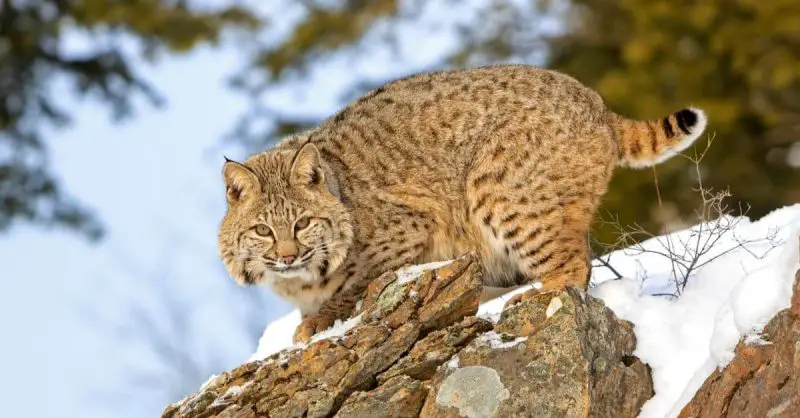Bobcats are among Michigan’s most elusive and fascinating predators. Known for their stealth and adaptability, these medium-sized wild cats have captured the curiosity of wildlife enthusiasts and researchers alike. Despite their widespread presence across the state, much about their daily lives and behaviors remains hidden, leaving room for intrigue and discovery. Understanding the secret lives of Michigan bobcats can shed light on their remarkable survival strategies, territorial habits, and role in the ecosystem.
Michigan’s diverse landscapes—from dense northern forests to marshy wetlands and sprawling suburban edges—provide ideal habitats for bobcats. Though sightings are relatively rare due to their secretive nature, careful observation and knowledge of their habits reveal a complex world of hunting, reproduction, and adaptation. In this article, we explore the detailed life of bobcats in Michigan, including their identification, behavior, diet, reproduction, distribution, and some fascinating facts that may surprise even seasoned wildlife watchers.
Understanding Bobcats in Michigan

The bobcat (Lynx rufus) is a native North American feline recognized for its medium size, distinctive markings, and solitary behavior. In Michigan, bobcats are present throughout the Lower and Upper Peninsulas, though populations are more concentrated in forested and remote areas. They are highly adaptable, able to thrive in environments ranging from dense woodlands to open meadows, and even near suburban developments when natural food sources are sufficient.
Bobcats are often mistaken for domestic cats or lynxes due to their size and fur patterns. However, they are easily distinguishable by their muscular build, short “bobbed” tails, and tufted ears. They are top predators within their ecosystems, controlling populations of small mammals and birds, thereby maintaining ecological balance. Understanding their physical and behavioral traits is crucial for those interested in wildlife conservation or simply observing these magnificent creatures in their natural habitats.
Physical Characteristics and Identification
Bobcats in Michigan have a robust body, typically measuring between 24 and 40 inches in length, with a weight range of 15 to 35 pounds. Males are generally larger than females. Their fur exhibits a tawny to reddish-brown color with black spots and streaks, which provides effective camouflage in wooded areas. A distinguishing feature is the short tail, often around 4 to 7 inches long, with a black tip that differentiates them from other wild cats.
The ears of a bobcat are pointed and tipped with small black tufts, reminiscent of lynx species. Their facial ruffs, the longer hair around the cheeks, give their face a distinct, angular appearance. Bobcats have large, powerful paws with retractable claws that allow them to move silently through underbrush. Their eyes are yellow or amber, providing excellent night vision, which supports their primarily nocturnal hunting habits. Recognizing these traits can help observers differentiate bobcats from other wildlife or feral cats.
Behavior and Daily Life
Bobcats are primarily solitary animals, except during mating season or when a mother is raising her kittens. They are highly territorial, with males often maintaining large ranges that may overlap with multiple females’ territories. Communication occurs through scent marking, visual cues, and vocalizations such as growls, hisses, and occasional screams during mating season.
Michigan bobcats are crepuscular, meaning they are most active during dawn and dusk, though they can be nocturnal if human activity encroaches on their territory. They are agile climbers and capable swimmers, which allows them to navigate varied terrains efficiently. While they are generally shy and avoid human contact, bobcats exhibit curiosity and intelligence, often learning to adapt to seasonal changes in prey availability and environmental conditions.
Hunting and Diet
As apex predators, bobcats in Michigan primarily feed on small to medium-sized mammals. Their diet includes rabbits, hares, squirrels, mice, and occasionally birds. They are ambush hunters, relying on stealth, patience, and sudden bursts of speed to capture prey. Bobcats often stalk silently through dense vegetation before launching a precise attack. Unlike pack hunters, bobcats rely entirely on their individual skills to catch food.
Their hunting behavior is influenced by season and prey availability. In winter, they may expand their range to locate sufficient food, sometimes taking advantage of weakened animals or scavenging carrion. Bobcats are also known to cache surplus prey, hiding it in brush or snow for later consumption. This strategic behavior ensures their survival during harsh winters when food is scarce.
Reproduction and Kittens
Bobcats in Michigan typically breed from February through April. During this period, males actively seek out females within overlapping territories. The gestation period lasts about 60 to 70 days, after which females give birth to litters of one to six kittens, commonly two to four. Bobcat kittens are born blind and helpless, relying entirely on their mother for warmth, food, and protection.
Kittens grow rapidly, beginning to explore their surroundings at around two months old. By six months, they are learning essential hunting skills under their mother’s supervision. Females tend to raise their young alone, while males do not participate in parental care. By the fall, juveniles often disperse to establish their own territories, a process that helps prevent inbreeding and ensures population balance across regions.
Habitat and Distribution in Michigan
Bobcats inhabit a variety of environments across Michigan, with a preference for dense forests, wetlands, and areas with abundant cover. Northern Michigan’s expansive woodlands provide ideal habitats, while Lower Peninsula bobcats are often found in mixed forests, swamps, and river corridors. They adapt well to fragmented habitats as long as prey and shelter are available.
Bobcats require a home range that meets their needs for food, shelter, and breeding opportunities. Male territories can span 15 to 50 square miles, while female territories are usually smaller. Seasonal movements occur in response to prey availability or mating pressures. Though elusive, bobcats are more likely to be detected through tracks, scat, or camera traps rather than direct observation, emphasizing the importance of indirect monitoring for wildlife studies.
Fun Facts About Michigan Bobcats
Bobcats possess fascinating traits that distinguish them from other felines in Michigan. For instance, despite being solitary hunters, they communicate through vocalizations and scent markings, which help maintain social boundaries without direct confrontation. Their spotted fur and tufted ears are not just for appearance; they play a critical role in camouflage and sensory perception in dense forests.
Another remarkable trait is their adaptability. Bobcats have been observed navigating suburban edges, taking advantage of small mammals and birds attracted to human activity. Unlike many predators, bobcats rarely prey on pets, focusing instead on natural prey species. Their resilience and resourcefulness make them an integral part of Michigan’s ecological tapestry.
Observing Bobcats in Michigan
Spotting a bobcat in the wild is a rare and rewarding experience. The best times for observation are during early morning or late evening, particularly in forested areas with limited human disturbance. Tracks in snow, claw marks on trees, and scat can provide valuable clues about bobcat presence and behavior.
While direct sightings are uncommon, wildlife enthusiasts can use remote cameras or guided tours in wildlife reserves to catch glimpses of these elusive cats. Patience and knowledge of their habits are essential, as bobcats are masters of concealment, blending seamlessly into their surroundings to avoid detection.
Conservation and Protection
Bobcats in Michigan are currently considered stable, with populations maintained through hunting regulations and habitat protection measures. Responsible wildlife management ensures that bobcat populations remain healthy while preventing overhunting or habitat loss. Protecting wetlands, forests, and natural corridors is crucial for maintaining the species’ long-term survival.
Understanding the secret lives of bobcats also fosters appreciation and awareness, encouraging residents to coexist peacefully with these wild predators. By preserving their natural habitats and respecting their space, humans can help maintain the ecological balance that bobcats contribute to throughout Michigan.
Conclusion
The secret lives of bobcats in Michigan reveal a remarkable blend of adaptability, intelligence, and stealth. These solitary predators navigate forests, wetlands, and even suburban areas with a combination of patience and skill, hunting, reproducing, and surviving with minimal human interference. From their distinctive physical traits to their fascinating behaviors and reproductive strategies, bobcats remain one of Michigan’s most intriguing wildlife species.
Though elusive, learning about bobcats enhances our understanding of Michigan’s ecosystems and the critical role these predators play in maintaining ecological balance. Observing and protecting these wild cats ensures that future generations can continue to marvel at their secretive yet captivating lives, tucked away in Michigan’s forests and woodlands.
FAQs About Bobcats in Michigan
What is the average size of a bobcat in Michigan?
Bobcats in Michigan typically measure between 24 and 40 inches in length and weigh from 15 to 35 pounds. Males are generally larger than females, and their muscular build allows them to be effective hunters.
Are bobcats dangerous to humans or pets?
Bobcats are generally shy and avoid humans. Attacks on people are extremely rare. They mainly prey on small mammals and birds, so pets may only be at risk if left outdoors unsupervised, particularly small cats or rabbits.
Where are bobcats most commonly found in Michigan?
Bobcats inhabit dense forests, wetlands, and remote areas throughout both the Upper and Lower Peninsulas. Northern Michigan’s forests provide ideal habitats, but they can also adapt to fragmented habitats with sufficient prey and cover.
How do bobcats hunt in the wild?
Bobcats are ambush predators. They rely on stealth and patience, often stalking prey quietly before making a quick, explosive attack. Their diet primarily includes rabbits, squirrels, mice, and occasionally birds.
When is bobcat mating season in Michigan?
Mating season occurs from February through April. After a gestation period of about 60 to 70 days, females give birth to one to six kittens, usually two to four, which the mother raises alone.
How can I spot a bobcat in Michigan?
Direct sightings are rare due to their secretive nature. Observers may find tracks in snow, scat, or claw marks on trees. The best chances of spotting them are during dawn or dusk in forested or wetland areas.
What fun facts make bobcats unique?
Bobcats have tufted ears and spotted fur that help with camouflage. They are solitary hunters but communicate through scent markings and vocalizations. They can also adapt to suburban edges without posing a significant threat to humans.






